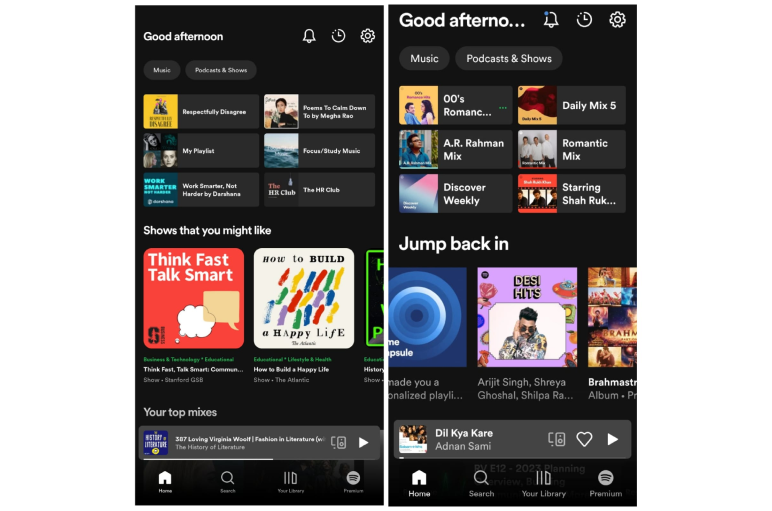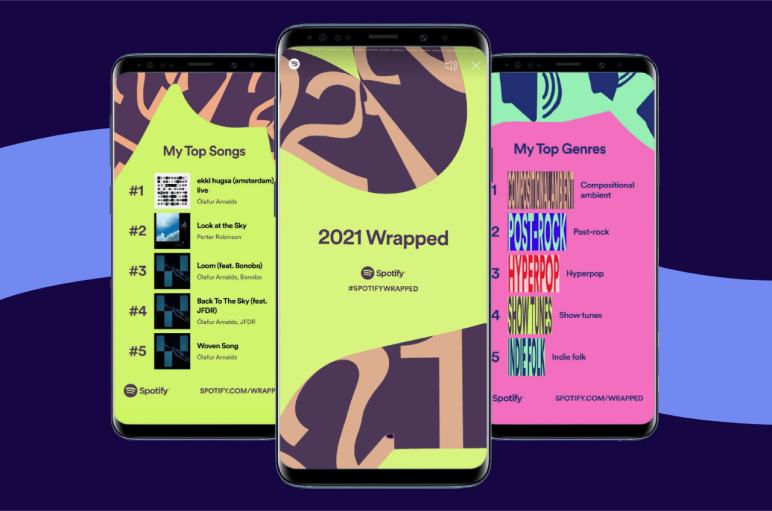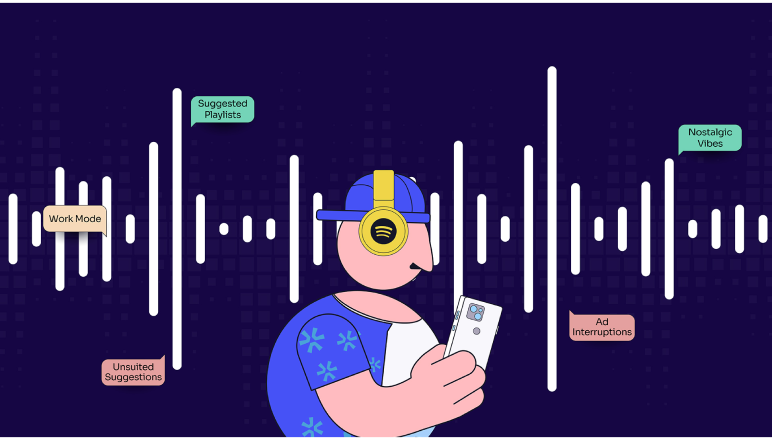How Spotify uses Machine learning to retain & grow 400+ million customers globally
When Spotify was launched in 2006, it was just like the good ol' iTunes and Pandora. But things changed when they opened gates to AI & Machine Learning for better personalization and allowed manual curation of mixed playlists by the users.
Fast forward today, Spotify has 400 million subscribers all over the world, among which, 180 million are paid subscribers. All thanks to the hyper-personalization methods considered by Spotify on the grounds of ML by analyzing customer data at its best!
Though many firms took a similar approach later, none could push the AI boundaries like Spotify when it came to enhancing user experience with customer insights and data. And, their acquisition of music intelligence firm just like ‘The Echo Nest’ is only taking Spotify closer to its goal - listeners won't have to take out phones from their pockets to change songs once they start listening without shutting the app for once.
How do Spotify's Recommendations Work?
Spotify's recommendation algorithms know your music tastes like your alter-ego. How do you think it does that? Well, thanks to ML models based on real-time user data sourcing - and, what lies at the heart of it - user data. The better more data Spotify gathers, the better it understands the customer, and the better personalization and recommendations it can ensure.
Spotify's recommendations algorithm, predictive AI is designed to predict what you will like based on your listening habits. It takes into account the following:
The major focus, however, remains on the Spotify Home Screen which is uniquely designed to cater to every user's music preferences - backed by customized music recommendations and personalized playlists.

Though there are many playlists like Release Radar, Mixtapes, and B Side; the "Discover Weekly" (an extension of the "Discover" tab) playlist stands out from the rest. Thanks to Spotify's AI called BaRT (“Bandits for Recommendations as Treatments”), which plays a major role in shelving and organizing your music recommendations based on individual preferences and listening history - and making the home screen of every Spotify user look unique.
Based on BaRT, Spotify comes up with Discover Weekly where they send a customized playlist of 50 songs to its users that they haven't ever heard about before - based on the data retrieved from their listening history and interests.
How Spotify does it is, however, unique.
Spotify focuses on tracking only four key statistics of every user,
- Skip rate (fewer number of skips = positive)
- Listening history (mood, style, genre)
- Playlist placements (personal, third-party & editorial playlists)
- Listening time (listening for more than 30 seconds)
- Social interactions (how many shares and where)
Once the data is there, the AI game begins.
Decoding BaRT - How Does the Spotify Algorithm Work?
To ensure optimum user experience, it would have been ideal for BaRT to take the granular approach and understand the music consumption style 1:1. While it's a great thought, imagine how cluttered and costly it would have gotten.
However, Spotify took a more effective approach of co-clustering playlists and users by finding a group with similar playlist interests and music tastes. How they find a group is by assessing the users and their playlists. For example, if a user listens to a playlist of sleeping things, BaRT will try to find more users of similar interests and group them in a co-cluster.
Spotify's BaRT model has majorly two modes - Exploration and Exploitation. While the Exploitation mode can only reap results when ample data is available for assessment, the Exploration mode works otherwise.
Exploration - The Discovery Engine of BaRT
"Instead of counting on user data, the Exploration mode recommends content to users based not on data but on uncertain prediction and then assesses their preferences to contribute to the data."
For example, if there's a new song that hasn't been played yet and doesn't have much data to address its potential - BaRT starts recommending it via its Exploration mode and gathers information. If the song has been majorly played for more than 30 seconds, it's considered to be positive and anything below that is negative. Such a process not only contributes to Spotify's extended music database but also helps newbie artists and creators showcase their talents on such a great platform.
Exploration - The Discovery Engine of BaRT
The BaRT model has also taken into consideration "Learn and Predict Satisfaction" - which is measured through consumption probabilities and click-through rates. With BaRT's Reinforcement Learning, the model constantly learns from its mistakes, logs, and retrains feedback to ensure maximum user satisfaction with correct predictions.

One of the most popular examples of Spotify's personalization is Wrapped, where they just wrap up the songs and playlists you listen to throughout the year and give you a personalized mixtape on December 1st. By collecting multi-channel user data and BI, and analyzing them - Spotify can assess individual preferences and ensure a more personalized experience.Millions of users share this to their social media accounts, leading to many organic sign ups to the Spotify platform.
AI Recommendation models used in Spotify
Spotify uses deep learning to automate the process and offer a personalized user experience by identifying latent patterns between artists, genres, and user preferences.
There are three recommendation models at work on Spotify:
Collaborative filtering
It is the technique that is used to automate predictions made about the users’ preferences considering their similar music tastes and their listening behaviors. Spotify uses the following technique to recommend songs and playlists to users which match their taste but have probably never heard about before.
For example, if User X has songs D, M, B, X, and G in their playlist and User Y has F, M, X, A, and G in their playlist - Spotify will start suggesting songs D and B from User X’s playlist to User Y and songs F and A from User Y’s playlist to User X because both of them majorly shares a similar taste in music.

Natural Language Processing for Content-Based Filtering
NLP, as you know, helps machines with the ability to read, understand, and derive the right meaning by processing natural human speech in real time.
By incorporating NLP and web crawling, Spotify tracks around 10 million websites to gather user data and analyze content on artists’ websites, blogs, and social media.
The NLP system is designed in such a way that it can identify certain terms and song-related noun phrases by classifying them into cultural vectors.
Audio Models and Convolutional Neural Networks
With the help of audio models, analyzing data from raw tracks and categorizing them becomes a piece of cake. Once the data is retrieved, it assists Spotify to evaluate the songs for recommendations despite its social presence.
For example, if a new artist releases a song online, it might not be possible for NLP to track it due to the low socio-coverage. But, by leveraging audio models and song data, it can be easily spotted with a collaborative filtering model.
Thanks to Spotify's adoption of convolutional neural networks (the same technology used for facial recognition) - however, the models aren't run on pixels but on audio data.
The Future of Music Recommendations with Spotify
Surely, figuring out how to recommend the right songs at the right time is a hard nut to crack - considering how diverse human tastes are. But with the right customer data and ML strategies at your disposal, recommending the majority of songs with positive feedback to each user won't be much of a hassle - as it would have been in case of biased and unscalable human recommendations.
Where Spotify is today - is all because of machine learning backed by user data, both internal and external. Such a unique strategy helps them understand their audience better, increase reach and chances of discovery led by predictive recommendations and in-depth understanding of customer preferences.
In the near future, Spotify has some major strategies aligned with their Reinforcement Learning (RL) through their ML model where their goal is to optimize their app for delayed rewards and aim for better customer engagement backed by top-notch audio experience.





